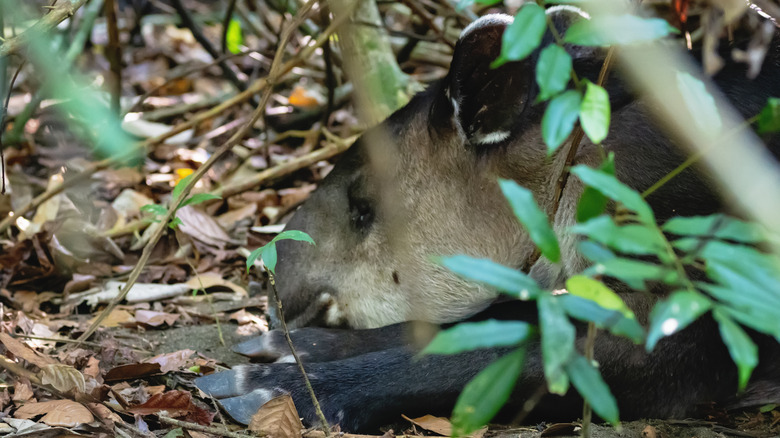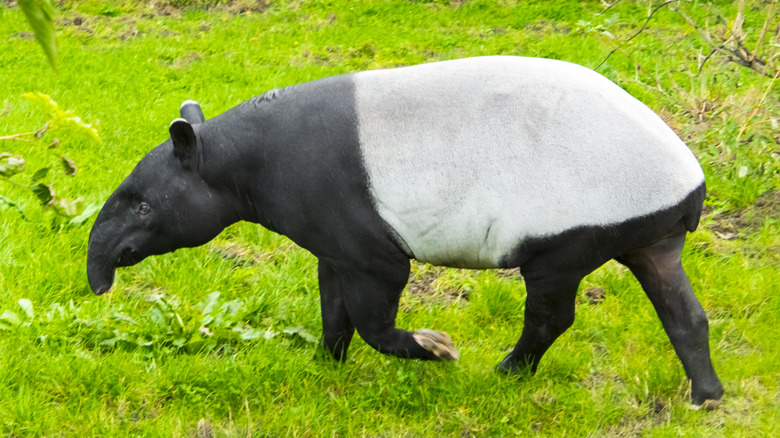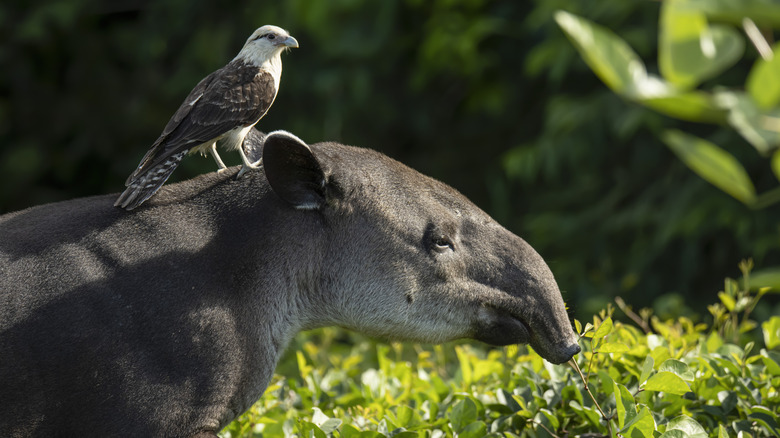The Strange Trunked Animal You Can Only Find In The Americas And Asia
Nature teems with unexpected marvels, from the skies where the largest birds of prey with massive wingspans soar to the seas that are home to the longest-living and strangest animals. When it comes to land mammals, many candidates exemplify the biodiversity and adaptability of nature. Yet, in the Americas and Asia, the tapir stands out as a strange-looking, trunked creature that demands attention.
There are four species of tapir: the lowland, Baird's, mountain, and Malaysian tapir. While each species has distinct traits, such as coloring, they all possess a striking appearance characterized by large, rounded bodies and long snouts that evoke comparisons to other animals like pigs, anteaters, and hippos. The tapir's prehensile nose can be used for foraging and functions as a snorkel when swimming. Their hooved feet have evolved to help them navigate dense forests. The tapir's front feet have three main digits and two supporting digits to aid in traversing various terrains, while its back feet have three digits. Tapirs have teeth similar to those of equids (horses, donkeys, etc.), with which they are closely related. All these unique features are attached to one big sturdy, rounded body, with the largest species, the Malayan tapir, standing between 40.2 and 51.2 inches tall and weighing 551 to 882 pounds.
Tapirs inhabit a vast range, from Mexico to the Andes in the Americas and Thailand to Sumatra in Asia. Despite this wide distribution, of the four species, three are listed as endangered, with the lowland tapir remaining vulnerable on the International Union for Conservation of Nature (IUCN) Red List. Much of the current discussion around the unique land mammal is, sadly, now focused on conservation.
Tapirs are ancient animals that are now facing extinction
The lineage of the modern tapir can be traced back approximately 50 million years, with its ancestors inhabiting a much wider range that included North America, Europe, and Asia. Tapirs typically live independently outside of mating season and raising their young: A calf will stay with its mother until it reaches 12 to 18 months of age. The gestation period of a tapir is long, 13 to 14 months, typically resulting in a single offspring. These low reproduction rates would not be concerning if it weren't for the modern-day threats posed by humans to their populations.
While there are pockets of tapirs in remote areas that thrive despite having natural predators like big cats, their survival is attributed to limited human interaction. Factors contributing to the tapir's current endangered or vulnerable status include hunting for meat, trophies, or traditional medicinal ingredients; habitat fragmentation caused by expanding roads and farms; and illegal logging and farming encroaching on protected areas.
Tapirs play a vital role in shaping the ecosystems where they live, earning them the nickname "gardeners of the forest," as they consume large amounts of fruit and disperse seeds through their scat. The efforts by conservation groups to preserve the tapir stem from both admiration and necessity for the broader ecosystems they inhabit.
Conservation efforts to help save the tapir are ongoing and face many challenges
There are some success stories in conservation efforts regarding the tapir, including the recent discovery of the large mammal in a protected area where it was previously thought to be extinct. For the lowland tapir, its populations throughout the Atlantic forests in Brazil, Argentina, and Paraguay have stabilized and even seen growth. A study published in Neotropical Biology and Conservation in January 2022 shared that the population of lowlands is estimated to be between 2,665 and 15,992, a wide range due to varying regional estimates. These population estimates represent a significant improvement from their numbers in the 1950s and the 1970s when the tapirs were almost hunted to extinction. Still, population growth alone doesn't guarantee long-term viability, and conservation remains critical.
The Tapir Specialist Group, established in 1980, now works with over 140 volunteer specialists involved in research and breeding programs to aid all four species of tapir. Those who wish to help ensure the tapir's long-term survival can make a direct donation to the organization. Behind the tapir's strange appearance lies a fight for survival. Conservation efforts aim to ensure future generations can still witness these remarkable creatures.


